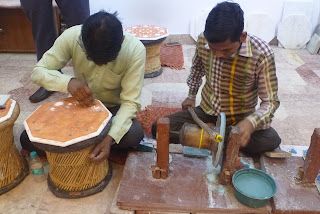 |
| Aravalli Mountains in the Tiger Preserve |
 |
| Huge Banyan Tree With a Doorway Through It |
 |
| Getting the Paperwork Done To Enter the Park |
This was not an American or Canadian National
Park. This Tiger Preserve is India at her finest, good and bad and like always
in India, somehow it all works OK. In 2005 the count of tigers in this preserve
was 26. Today, even though there has been some poaching, the total count for
the 2014 census was 62 tigers. India is committed to preserve her Bengal
tigers. Bengal Tiger because millennia ago Siberian Tigers moved South passing
the Bay of Bengal, settling in India. They became their own species.
 |
| Sambar Deer |
 |
| Arrowhead Coming Out of the Tall Grass |
The natural age for a tiger is about 16 years. Some turn 20 but it's rare. Males weigh on average 500 lbs, females about 280 lbs. In 1939 a male tiger was shot weighing just below 900 lbs. They can run at over 80 km per hour for short distances. Tigers are territorial, with some overlaps. Males have a very large territory that contains several female territories. Man is the only real competition for a tiger’s territory. Even though India spends millions of rupees to save the tigers, the total population is on a downward curve for all of India. Female tigers have a ‘core’ area where they hang out, and the rangers in the park seem to know where those areas are. But this is not a real science; tigers change their core areas often and at will. So we were very lucky to have seen tigers when we visited. Carol spotted a grey cougar but it quickly disappeared into the bush. There was no time to photograph it. It is rare to spot a cougar so she was very lucky.
 |
| The Remains of Arrowhead's Diner |
The first tigress we saw was near a lake, hidden in the tall grass, her hangout place. You could spend days looking at the
 |
| The Markings Between Her Eyes Resemble An Arrowhead |
 |
| A Magnificent Animal |
 |
| So Beautiful |
 |
| Mr. Singh, A Most Remarkable Man |
 |
| Can You See Her? |
For the afternoon we were lucky to have gotten admission again, thank you Dinesh, and again we were lucky to gain access to 3 jeeps for our group. Naturally we tried the grassy area again, hoping to see Arrowhead once more, but of course she saw us and did not show. We checked on the antelope carcass but there was no change. Nobody ate the rest of the antelope but we could tell the heat had started to blow up the carcass. So, Dinesh spoke with one of the wardens and we were allowed to change sectors and drive
 |
| The Lady of the Lake |
 |
| Tree-pie Birds Fighting Over the Seeds Dinesh Put In His Hat |
We spent a good hour waiting to see more of Lady but then some of our group got antsy so we called it quits. Instead we visited what might be the largest Banyan tree in India. Tree is the wrong word, trees would be better. Banyan spread by using air roots and this tree had spread wide and majestically.
We were also lucky enough to see wild boars, a white owl, lots of spotted deer and peacocks, mongoose and monkeys. We stopped in one area and the Tree-pie birds were eating seeds out of our hands and from Dinesh’s hat.
 |
| Tree-pie Birds Love Those Seeds |
Throughout the park are very old buildings, castles, temples, walls etc. now abandoned so that the preserve is truly left to the wildlife, to the tigers. It is a wild, natural preserve. Will it be large enough to save the tiger? There are people totally dedicated to saving the tiger. Dinesh seems to be one of those men. Mr. Singh, the speaker is one of those men. And then there is Mr. M.D. Parashar, an artist. He draws tigers. His art is in the U.S. White House. We met him late at night thanks to Dinesh. Those 2 men are friends.
 | ||
| Mr. Parashar Made This Portrait of Arrowhead With Soot and a Small Piece of Twisted Newspaper |
 |
| Mr. Parashar With His Art and Us |
I was told the park is still owned by a Maharajah, that India only has been given the right to use it as a tiger preserve. Not sure if that is true though, I cannot find anything on this on the internet.
The study of tigers, the protection of the species
is a large and intricate science and there is a large brotherhood of tiger
conservationists among people in India. Dinesh is part of that group.
Sariska Tiger Foundation
D-4, Malviya Marg, C-Scheme, Jaipur, India







